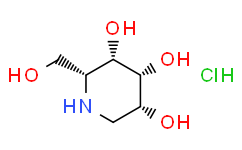| Cas No.: | 75172-81-5 |
| Chemical Name: | Migalastat HCl |
| Synonyms: | 3,4,5-Piperidinetriol,2-(hydroxymethyl)-, hydrochloride (1:1), (2R,3S,4R,5S)-;1-Deoxygalactonojirimycin Hydrochloride;Deoxygalactonojirimycin Hydrochloride;(+)-(2R,3R,4R,5S)-2-hydroxymethyl-3,4,5-trihydroxypiperidine hydrochloride;(+)-1-deoxynojirimycin hydrochloride;(1R,3R,4R,5S)-3,4,5-trihydroxy-2-(hydroxymethyl)piperidinium chloride;(2R,3S,4R,5S)-2-(Hydroxymethyl)piperidine-3,4,5-triol hydrochloride;1,5-dideoxy-1,5-imino-D-glucitol hydrochloride;1-DEOXYMANNOJIRIMYCIN HCL;1-DeoxymannojirimycineHCl;1-Deoxymannojirimycinehydrochloride;DEOXYMANNOJIRIMYCIN HCL;DEOXYMANNOJIRIMYCIN,HYDROCHLORIDE;DEOXYMANNONOJIRIMYCIN HCL;DMJ,HYDROCHLORIDE;DMM |
| SMILES: | Cl.OC[C@H]1NC[C@@H](O)[C@@H](O)[C@H]1O |
| Formula: | C6H13NO4 |
| M.Wt: | 163.17 |
| Purity: | >98% |
| Sotrage: | 2 years -20°C Powder, 2 weeks 4°C in DMSO, 6 months -80°C in DMSO |
| Description: | Migalastat hydrochloride (1-Deoxygalactonojirimycin hydrochloride) is a potent and competitive inhibitor of α-galactosidase A (α-Gal A) with an IC50 of 0.04 μM for human α-Gal A. |
| In Vivo: | Fabry disease is an X-linked recessive disorder caused by the deficient activity of α-galactosidase A. α-Gal A activity in heart, kidney, spleen, and liver is increased dose- and time-dependently in transgenic mice that express human mutant alpha-Gal A with migalastat hydrochloride treatment. The half-life of DGJ is less than 1 day in all major issues and that of the enzyme synthesized during the DGJ treatment period is approximately 4 days[2]. Oral administration of migalastat hydrochloride reduces tissue GL-3 in fabry transgenic mice, and in urine and kidneys of some FD patients. Oral administration of migalastat hydrochloride to transgenic mice reduces elevated lyso-Gb3 levels up to 64%, 59%, and 81% in kidney, heart, and skin, respectively, generally equal to or greater than observed for GL-3[3]. |
| In Vitro: | Both IC50 and Ki values of migalastat hydrochloride toward human lysosomal a-Gal A are 0.04 μM[1]. |
| Animal Administration: | Mice: Migalastat hydrochloride is dissolved in drinking water. Age-matched male homozygous TgM, TgM/KO, and nontransgenic (Non-Tg) C57BL/6 mice are supplied drinking water containing DGJ ad libitum. Body weight is monitored weekly during the DGJ treatment period. Average daily DGJ dosage is estimated based on the consumption of drinking water. Mice fed drinking water containing DGJ at 0.05 mM typically received DGJ at approximately 3 mg/kg body weight/day[2]. |
| References: | [1]. Asano N, et al. In vitro inhibition and intracellular enhancement of lysosomal alpha-galactosidase A activity in Fabry lymphoblasts by 1-deoxygalactonojirimycin and its derivatives. Eur J Biochem. 2000 Jul;267(13):4179-86. [2]. Ishii S, et al. Preclinical efficacy and safety of 1-deoxygalactonojirimycin in mice for Fabry disease. J Pharmacol Exp Ther. 2009 Mar;328(3):723-31. [3]. Young-Gqamana B, et al. Migalastat HCl reduces globotriaosylsphingosine (lyso-Gb3) in Fabry transgenic mice and in the plasma of Fabry patients. PLoS One. 2013;8(3):e57631. |

 DC Chemicals' products qualify for U.S. tariff exemptions. We guarantee no price increases due to customs duties and maintain stable supply, continuing to deliver reliable research solutions to our American clients.
DC Chemicals' products qualify for U.S. tariff exemptions. We guarantee no price increases due to customs duties and maintain stable supply, continuing to deliver reliable research solutions to our American clients.





















